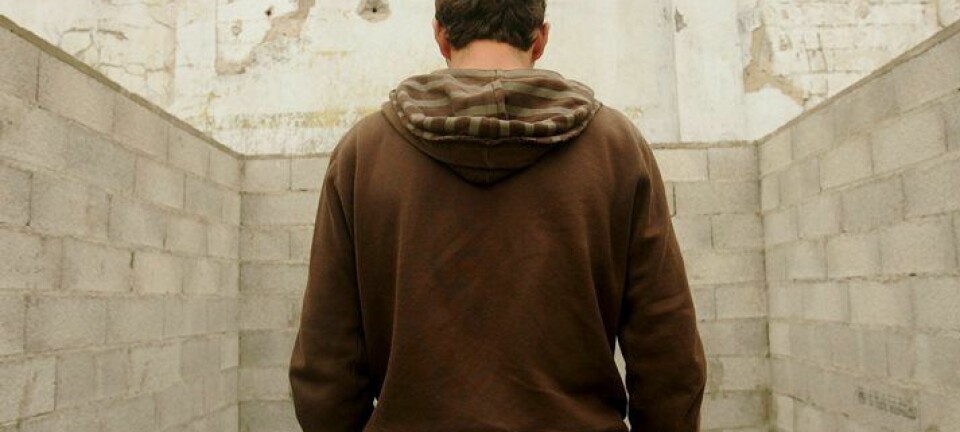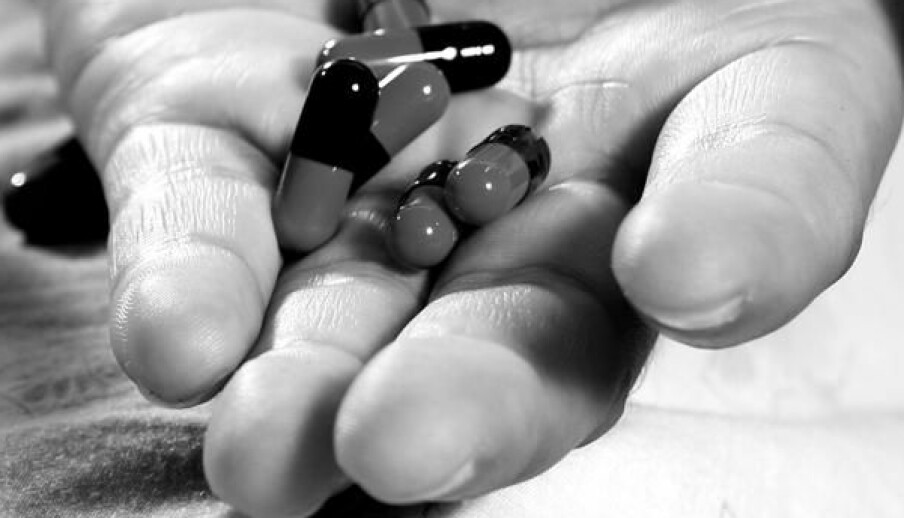
Suicide researcher is more optimistic than in a long time
Youth who repeatedly injure themselves, think about suicide or try to commit suicide have not always received the right treatment. Now scientists are beginning to better understand what helps.
Lars Mehlum is a professor and the founding director of the National Centre for Suicide Research and Prevention at the University of Oslo. He is the principal researcher behind a new study on the long-term effects of dialectical behaviour therapy (DBT).
In this study, the researchers have followed 77 adolescents aged 12 to 18 who have repeatedly injured themselves or tried to take their own lives. One group received traditional psychotherapy, and the other group received DBT treatment.
After three years of follow-up care, findings show that the DBT group has a reduced incidence of suicide attempts and self-harm.
The researchers have been following these patients for three years and have found that the positive effects of treatment were not limited to the 19-week treatment period. The results also show that there are significant differences between the two groups.
When suicide becomes the only solution
When you are so depressed that you think about killing yourself, it’s usually because you’re experiencing unbearable emotional pain, Mehlum says.
That pain leads some people to think: “Nothing can help. This won’t ever end. I can't bear to live like this forever.” The idea of suicide can be experienced as a solution: “At least that’s something I can do!”
A person carrying such intense pain may initially feel relief from this thought. Just knowing that you have a way to end the suffering can make you a little less desperate.
“Unfortunately, this relief reinforces the thought. When something helps with a problem, you’re likely to attempt the solution faster next time,” says Mehlum.
The same goes for self-harm, he says. Research has proven this in many ways, including through the use of functional magnetic resonance x-ray (FMRI). This research shows which centres of the brain are involved in this reinforcing effect of self-harm. The self-harm triggers a dampening effect on the centres responsible for stress reactions and fear.
Therapy works like a razor blade
Now research is showing that psychotherapy can also block this self-harm effect and even replace the need for it.
In their recent article, the researchers describe how they measured what happens during dialectical behaviour therapy treatment. Rather than using brain measurements, they used interviews and self-reporting.
Measurements taken during therapy showed a sharp reduction in adolescents’ thoughts of hopelessness. The results also show that the treatment not only provided an immediate effect but also lasted for three years. The researchers are eager to find out whether the effects of treatment will extend to young adulthood for these teens. They want to continue the study and see how this group has progressed ten years after treatment.
DBT differs from other therapies in that adolescents learn coping strategies. These can be used to regulate their emotions and cope with difficult life situations when they might otherwise resort to self-harm or other destructive ways to cushion their inner pain.
Through learning and practicing coping skills, the teens are better equipped to find their life worth living. One of the takeaways is a packet of skill cards they can carry with them. During the treatment period, they also have the opportunity to contact their therapist outside of office hours and get help applying the skills.
When everything turns black
Many young people, perhaps most, may experience chaos in their lives and times when everything just looks black.
But the adolescents that Mehlum and his colleagues are researching and treating are different from their healthy peers. Often they have a biological vulnerability that makes them unable to cope with certain types of persistent stress. This stress can trigger changes in the brain and eventually cause depression.
“These youth have stronger negative feelings than their peers. They react by getting angry, upset or afraid more often when experiencing relatively minor challenges and conflicts with family, friends, teachers or others. They can feel desperately unhappy.
What is especially important in DBT treatment is providing hope, without trivializing or exaggerating what the teens are experiencing.
Other research shows that blue light and psychiatric hospitalization are not the best treatment for adolescents with this behaviour pattern.
“We need to be clear that what young people experience is serious. We’re also clear that self-harm and suicidality aren’t solutions, but are a recipe for making things more difficult or even dying. But we always have to strike a balance between the challenge and seriousness on the one hand and hope and support on the other,” says Mehlum.
Rewarding way to work

DBT therapy is not entirely new in Norway. In the past decade, the treatment has been implemented in more than 40 locations in the country, of which 23 have their own treatment programs for adolescents. The therapy is now becoming a permanent form of treatment throughout Norway.
Norway has about 500 DBT-trained therapists.
Melissa Ramsland is one of them. She is a clinical nurse with a specialization in mental health work. She works at Stavanger University Hospital on the Emergency outpatient youth team. For 20 per cent of her time, she works as part of a team that offers DBT.
In her DBT time, Ramsland works with youth who struggle with emotion regulation difficulties, self-harm and suicide problems.
She has previously worked with the same group of adolescents who had been admitted to psychiatric hospitals. She was often frustrated at not having adequate tools and frameworks to offer effective help.
She believes that DBT treatment enables her to work more effectively.
“This is a rewarding way to work. The goal of the treatment is to replace problems with solutions and give young people concrete skills and more constructive ways to handle difficult situations. Many of these youngsters often think in black or white. We help them find the nuances. The goal is for them to have a life that feels worth living,” Ramsland says.
Less self-destructive behaviour
Accessibility is key for this treatment. The same therapist who follows the youth during treatment is therefore available to help by phone outside regular working hours.
Ramsland believes it works well to have the responsibility for treatment located in one place, so that the adolescents don’t have as many people to deal with. The same arrangement applies for relatives and close friends, which is also a key part of DBT. Parents or guardians participate in parenting groups, which prove to be very important.
“These young people may have reaction patterns that can be challenging for the people closest to them. When family members become more knowledgeable about what’s behind this behaviour and acquire better tools to meet the youth, the problems are less likely to escalate. These are often young people who are perceived as ‘difficult’ but who are experiencing a lot of suffering,” Ramsland says.
“We get very good feedback on the treatments, both from the young people themselves and their loved ones. I interpret that as a sign that they find the treatment meaningful. We also see a noticeable reduction in self-destructive behaviour and less need for hospitalization,” says Ramsland.
Talk about suicide!
Our survival instinct is a strong driving force in us.
Because people prefer to live, it is uncommon for a person to commit suicide impulsively, says Mehlum. But there are exceptions. Impulsive suicides are more common among young people, often when they are under the influence of drugs or alcohol, or in an acutely difficult life situation. These incidents can be compared to a car accident. The intention is not to die, but the conditions in the situation are so risky that a “psychological accident” can happen.
Most people have thought about suicide many times before they finally act on it. Many of those who die by suicide have a history of self-harm or suicide attempts.
“This delay in taking action provides a golden opportunity and a window of time to detect suicide risk and do something,” Mehlum says.
That’s why it’s important to pay attention. And to dare to talk about the topic, he says.
“If you know someone who doesn’t seem to be doing well, it’s important to ask what’s going on. It’s also important not to hold back from asking if they’ve thought about taking their own life. It’s a myth that if we ask, it can trigger suicide. No research shows this to be true. If more people would dare to ask, we could save more lives,” says Mehlum.
The centre he heads is working with other agencies right now to create a nationwide public awareness campaign that will include the message that it isn’t dangerous to talk about suicide, and you can get help. This has been tried in the Stavanger region with good results, says Mehlum.
Is all the openness good?
The media used to be very reluctant to mention suicide. The ethical press guidelines stated that suicide should not be mentioned "except in extraordinary cases." The view at the time was that the mention of suicide could have a contagious effect.
Writing about suicide opened the door a crack in 2006. Now, in 2019, one can find quite a lot of openness about suicide in the media.
Mehlum thinks that's good.
“Most things that are written and told in public about suicide are good. In fact, today we talk more and more about the so-called Papageno effect, that is, the preventive effect of telling stories in public about how people can be helped to choose not to take their own lives.
Mozart's opera The Magic Flute gives this effect its name, where the bird-catcher Papageno is thinking about taking his own life because he is convinced that his beloved has disappeared forever. But then three boys come on stage and remind him that life is short, but death is forever and that he should therefore stop and think. There are alternatives to dying.
But not all media coverage is equally constructive, Mehlum says.
“Mentioning suicide in a sensational or romantic way can increase the likelihood of suicide contagion. A good example is when American actor Robin Williams took his own life. This led to a sharp increase in suicides in both the US and the UK.”
The media in many countries also wrote in great detail about the method Williams used to kill himself. Researchers also know that this can contribute to more suicides.
Reference:
Mehlum L. et al: Long term effectiveness of dialectical behavior therapy versus enhanced usual care for adolescents with self‐harming and suicidal behavior, The Journal of Child Psychology and Psychiatry.
———


































